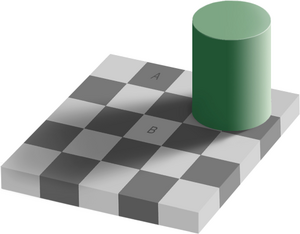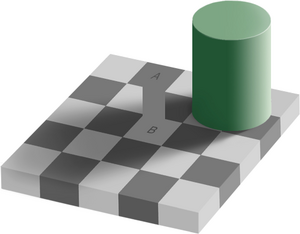Difference between revisions of "Same color illusion" - New World Encyclopedia
({{Contracted}}) |
|||
| Line 4: | Line 4: | ||
| − | The '''same color illusion''' | + | The '''same color illusion''' (also known as '''Adelson's checker shadow illusion''', '''checker shadow illusion''' and '''checker shadow''') is an [[optical illusion]] in which identical shades of gray appear to be different. |
| − | + | ==Discovery== | |
| + | The illusion was first published in 1995 by [[Edward H. Adelson]], Professor of [[Vision Science]] at [[Massachusetts Institute of Technology|MIT]].<ref name="JudgeMaterial">{{cite web|url=http://web.mit.edu/persci/people/adelson/checkershadow_illusion.html|title=Checkershadow Illusion|first=Edward H.|last=Adelson|year=2005|accessdate=2007-04-21}}</ref> | ||
| − | + | ==Description== | |
<center> | <center> | ||
{| style="float: center}} | {| style="float: center}} | ||
| Line 17: | Line 18: | ||
</center> | </center> | ||
{{clr}} | {{clr}} | ||
| − | + | The same color illusion shows what appears to be a checkerboard made of dark and light gray squares. Resting in one corner of the checkerboard is a green cylinder that casts a shadow diagonally across the middle of the board. Two of the squares on the board are labelled "A" and "B". When studying the image, square A appears markedly darker than square B, even though they are the exact same shade of gray. If one removes the image surrounding the two squares (or covers it over with a paper), it is clear that they are the same shade. | |
| − | == | + | ==Explanation== |
| − | As a | + | [[Image:Aniopticalillusion.gif|thumb|right|The two As are the same color.]] |
| + | When looking at the image, the brain and visual system interprets it as a three dimensional image. When interpreting scenes in real life, the visual system has techniques that compensate for different lighting and shadows, enabling us to better interpret objects as they actually exist. There are several specific aspects that contribute to the remarkable success of this illusion. | ||
| + | |||
| + | First, lighter squares surrounded by darker squares appear lighter than average based on local contrast. Conversely, darker squares surrounded by lighter squares appear darker for the same reason. Second, the shadow of the cylinder has soft edges. The visual system tends to ignore gradual changes in light level, focusing instead on sharp edges. Additionally, certain colors such as gray, green, and yellow are more difficult for the visual system to judge accurately. Often, cues for these colors are taken from the surrounding context. As can be seen in the same color illusion, when the context is removed, it is obvious that the two gray squares are the same shade.<ref>Nemiroff, Robert and Jerry Bonnell. [http://64.233.169.104/search?q=cache:zfV6C9V3bPoJ:www.bangkokpost.net/education/site2007/nf2jl2407.htm+adelson+checker&hl=en&ct=clnk&cd=9&gl=us&client=firefox-a "The same color illusion"] Bangkok Post. July 24, 2007. Retrieved October 26, 2007.</ref> | ||
| + | |||
| + | ==Applications== | ||
| + | The same color illusion aptly demonstrates why it is so important to verify what may seem like obvious assumptions when conducting scientific experiments. The human eye and brain can be easily fooled into misinterpretations, which could affect the results of any number of scientific inquiries. | ||
==Notes== | ==Notes== | ||
<references/> | <references/> | ||
| − | |||
| − | |||
| − | |||
| − | |||
| − | |||
==External links== | ==External links== | ||
Revision as of 19:47, 26 October 2007
The same color illusion (also known as Adelson's checker shadow illusion, checker shadow illusion and checker shadow) is an optical illusion in which identical shades of gray appear to be different.
Discovery
The illusion was first published in 1995 by Edward H. Adelson, Professor of Vision Science at MIT.[1]
Description
The same color illusion shows what appears to be a checkerboard made of dark and light gray squares. Resting in one corner of the checkerboard is a green cylinder that casts a shadow diagonally across the middle of the board. Two of the squares on the board are labelled "A" and "B". When studying the image, square A appears markedly darker than square B, even though they are the exact same shade of gray. If one removes the image surrounding the two squares (or covers it over with a paper), it is clear that they are the same shade.
Explanation
When looking at the image, the brain and visual system interprets it as a three dimensional image. When interpreting scenes in real life, the visual system has techniques that compensate for different lighting and shadows, enabling us to better interpret objects as they actually exist. There are several specific aspects that contribute to the remarkable success of this illusion.
First, lighter squares surrounded by darker squares appear lighter than average based on local contrast. Conversely, darker squares surrounded by lighter squares appear darker for the same reason. Second, the shadow of the cylinder has soft edges. The visual system tends to ignore gradual changes in light level, focusing instead on sharp edges. Additionally, certain colors such as gray, green, and yellow are more difficult for the visual system to judge accurately. Often, cues for these colors are taken from the surrounding context. As can be seen in the same color illusion, when the context is removed, it is obvious that the two gray squares are the same shade.[2]
Applications
The same color illusion aptly demonstrates why it is so important to verify what may seem like obvious assumptions when conducting scientific experiments. The human eye and brain can be easily fooled into misinterpretations, which could affect the results of any number of scientific inquiries.
Notes
- ↑ Adelson, Edward H. (2005). Checkershadow Illusion. Retrieved 2007-04-21.
- ↑ Nemiroff, Robert and Jerry Bonnell. "The same color illusion" Bangkok Post. July 24, 2007. Retrieved October 26, 2007.
External links
Credits
New World Encyclopedia writers and editors rewrote and completed the Wikipedia article in accordance with New World Encyclopedia standards. This article abides by terms of the Creative Commons CC-by-sa 3.0 License (CC-by-sa), which may be used and disseminated with proper attribution. Credit is due under the terms of this license that can reference both the New World Encyclopedia contributors and the selfless volunteer contributors of the Wikimedia Foundation. To cite this article click here for a list of acceptable citing formats.The history of earlier contributions by wikipedians is accessible to researchers here:
The history of this article since it was imported to New World Encyclopedia:
Note: Some restrictions may apply to use of individual images which are separately licensed.
—Jeff Anderson 16:35, 17 September 2007 (UTC)


